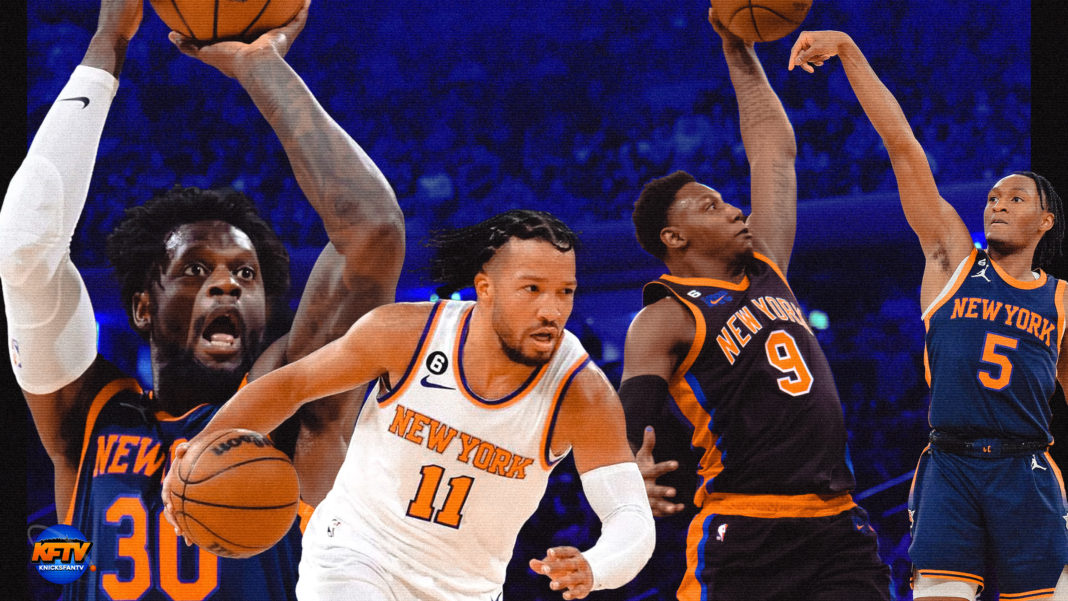The New York Knicks have a top 10 offense which is confusing. Here is a look at how their offense works and some potential pitfalls.
If you scroll through Knicks Twitter during or after a New York Knicks game, you are more likely than not to see an abundance of tweets critiquing the Knicks’ approach on offense. Too many isolation possessions, a lack of ball movement, and a slow pace are among the Knicks Faithful’s favorite critiques to air their grievances about when watching this team play.
Yet, many of these same Twitter naysayers are confused when they scan the stats page on NBA.com because they find out New York has the 9th-best offensive rating in the NBA. Since Tom Thibodeau implemented a nine-man rotation and glued Cam Reddish, Derrick Rose, and Evan Fournier to the bench on December 4th, the Knicks have the 7th-best offensive rating in the league (prior to that, the team ranked 12th).
The eye test and constant frustrations when watching the Knicks play on this side of the ball do not align with the numbers regarding overall offensive efficiency. So the question becomes: How do the Knicks have a Top 10 Offense despite their clunky approach?
There are some qualities the Knicks do exceptionally well on the offensive side of the ball, and above all else is offensive rebounding. Since December 4th, the Knicks are second in offensive rebounding percentage, per NBA.com Stats. And that makes sense considering Mitchell Robinson, Isaiah Hartenstein, Jericho Sims, and Julius Randle are all close to or above the 90th percentile in offensive rebounding percentage for their positions, per Cleaning the Glass.
So the Knicks’ knack for grabbing offensive boards leads to a league-leading mark in second-chance points (NBA.com Stats) and boosts the team’s overall offensive rating. The beauty about New York’s potent offensive rebounding is that it leads to putback plays (generally more efficient than halfcourt offense) and quick kick-outs to open shots on the perimeter if the defense is out of position. Simply put, the Knicks create more opportunities for higher percentage shots via offensive rebounds.
The next area where the Knicks excel is protecting the basketball. Since the switch to the nine-man rotation, the team ranks 5th in the NBA in turnover percentage, per NBA.com Stats. Jalen Brunson is a standout in this category, placing in the 95th percentile in turnover percentage among point guards, per Cleaning the Glass. The result of New York’s ability to not turn over the ball is that there are more possessions with scoring opportunities, and more opportunities to score means more points per possession overall.
Another strength for the Knicks is getting to the free throw line. Now, while some Knicks have had trouble converting at the charity stripe, the expected value of points from two free throws at just an average rate is higher than that of a two or three-pointer at an above-average rate.
From December 4th, the Knicks are 5th in the league in free throw attempt rate (relative to field goal attempts), per NBA.com Stats, and here is why:
• RJ Barrett and Julius Randle are both above the 90th percentile for their positions in shooting fouled percentage (percentage of field goal attempts the player was fouled), per Cleaning the Glass.
• Jalen Brunson and Immanuel Quickley also get to the line right around the 70th percentile and are just below the 90th percentile in And-one Percentage, per Cleaning the Glass.
Since all four of these Knickerbockers are adept at drawing fouls and getting to the line, it is another dimension to the Knicks’ offense to stay competitive in games (and also slows down the rhythm for their opponents).
The above three areas in which New York shines represent three of the Four Factors of Basketball Success. Unfortunately, the Knicks fall short in the most critical area of the Four Factors: Shooting.
Once again, using that same time frame (December 4th), New York ranks 25th in effective field goal percentage per Cleaning the Glass. But to put a slightly positive spin on this poor shooting display, the team is 15th in location field goal percentage, a measure used to gauge a team’s shot profile (Cleaning the Glass). In other words, the Knicks don’t make shots at a high rate, but at least the team’s shot location profile is middle of the pack in terms of efficiency. So while it’s great to see the Knicks ranked ninth in overall offensive rating, a distinction we haven’t seen since the 2012-13 season, the sub-par shooting numbers are what ultimately might hurt this team if it finds itself in the playoffs this spring.
Now diving a little deeper into the Knicks’ offensive approach, the eye test does agree with the numbers on this: the team has a relatively high share of isolation possessions. The only four teams with a higher isolation frequency than the Knicks are the Dallas Mavericks, Philadelphia 76ers, Brooklyn Nets, and Los Angeles Lakers, per NBA.com Stats. And what do these four teams have in common that the Knicks do not? They all have 1-2 players who are among the elite offensive talents in league history.
To New York’s credit, it’s tied for 11th in isolation points per possession, a competent efficiency level given the volume (NBA.com Stats). Julius Randle and Jalen Brunson have respectable isolation production compared to some of the top guns of these other teams (see chart below). The problems may arise if the Knicks make the postseason, where defenses can key in on Brunson and Randle, who have limited to no real postseason success.

We’ve already seen the reliance on iso-ball hurt the Knicks in the fourth quarter, where the defense is the closest thing to playoff intensity that a team will see during the regular season. The Knicks may have a Top 10 offensive rating overall, but in the fourth quarter alone, the team ranks 22nd since December 4th (see chart below), per NBA.com Stats. The efficient offense in the first three quarters of games drives up the team’s overall offensive rating.

In conjunction with the Knicks’ isolation-heavy basketball approach, it should be no surprise that New York is also 30th in assist percentage (25th in the fourth quarter alone), per NBA.com Stats. So ball movement is another concern for Knicks fans who scream “pass the rock!!!” at the TV screen for three to four nights a week. There is nothing wrong with wanting to feature the team’s best players late in the game, but only at the expense of a certain predictability threshold. The Knicks need to do a better job involving other guys and creating more movement rather than relying on Randle and Brunson to hold the ball and take difficult contested shots.
The Knicks have established an identity on offense consisting of using brute force to attack the rim, get to the free throw line, and create second-chance opportunities, all while protecting the basketball at a high rate. This identity makes it a pain for other teams to deal with the Knicks on most nights, and at the very least, Knicks fans can be proud of that. Hopefully, as New York enters its final 30 games of the regular season, the team’s weaknesses and late-game woes can improve before entering a potential play-in game or first-round series in April.
Stay tuned to KnicksFanTV.com for the latest Knicks news, rumors, and recaps throughout the NBA season. And in case you missed it, check out Alex on New York Post x SNY on RJ Barrett’s benching and if the Knicks should make a move before the trade deadline.















